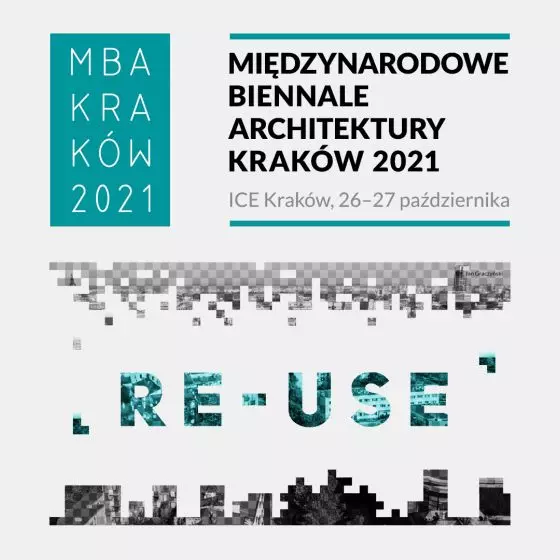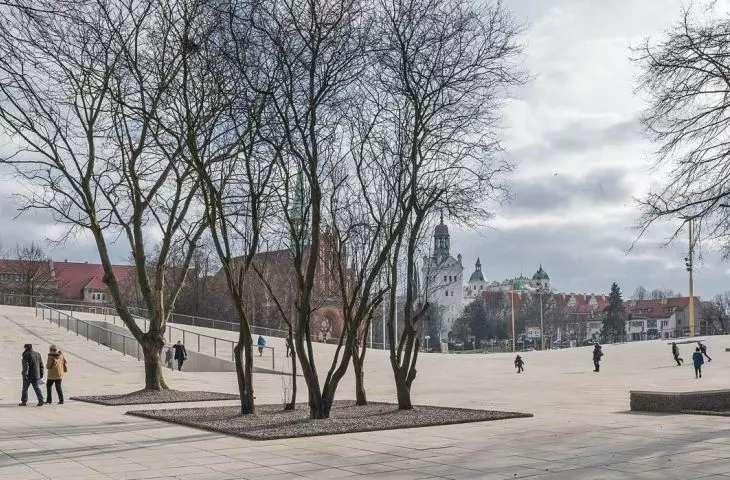More greenery, new small architecture and lighting. All this is to appear in Szczecin's Solidarity Square and within the area of the Breakthroughs Dialogue Center underneath. On the initiative of the designer himself , thelocal authorities are trying to modify the square.
Just six years after the completion of Szczecin's Breakthroughs Dialogue Center and the Solidarity Square above it, a "facelift" is being prepared for both projects. Kurier Szczeciński (24kurier.pl) reported on the planned changes to the iconic space and museum by Robert Konieczny's KWK Promes studio. The square is to be renovated after - as the article put it - "years of heavy use." The facades of the "Breakthroughs" are to be replaced, the "memorial wall," small architecture and lighting will undergo changes, and - perhaps most importantly - new plantings will appear.
"Kurier" quotes Voivodeship Marshal Olgierd Geblewicz:
For several months we have been discussing with the designer about what I would call an ecolifting of the square.
The authorities are keen that, in addition to historical symbolism, the square should reflect the long-term strategy of the local government, which is trying to bet on ecology, advertising the city with the slogan "Szcecin. Floating garden 2050." The provincial board last week gave the green light to the "facelift" and the Szczecin National Museum, which manages the Gorges. Work on the concept by KWK Promes is expected to be completed by December.
pattern to be corrected
The design of the Breakthroughs is the result of a competition announced in 2009. Implementation was completed in 2015. However, the controversy it aroused in Szczecin was mainly about symbolic issues, not natural ones. After all, in the space of the square stands a monument to the Victims of December 1970, and the square itself was the scene of the Szczecin riots, which the sculpture commemorates. Veterans argued that the sloping space allowing, among other things, the stunts of skateboarders does not fit with the solemnity of the place. These voices quieted down when the realization received architectural trophies (the square - the best public space in Europe in the European Prize for Urban Public Space 2016 competition, the "Gorges" - the best building in the world in the World Architecture Festival 2016 competition), and Szczecinians voted for the square with their feet.
Regardless of the awards and the acceptance by residents, the space above the Breakthroughs Dialogue Center has been stirring controversy all along, especially on the wave of growing criticism of the "concretization" that has taken over the public spaces of Polish cities. In the spring of this year, on the occasion of the highly publicized conversion of Wolności Square in Kutno into a parking lot, Agata Twardoch spoke out on Facebook:
Recall [...] what object recently won the prestigious "Life in Architecture" competition as Poland's best public space of 2015-2019? [...]. Was it full of greenery, providing natural retention, a lively and friendly space, responding to the needs of all generations, and, on top of that, an exemplary response of the city to climate change? Well, no! A large concrete slab with concrete platforms of unidentified purpose, hiding an additional function underneath (i.e., Szczecin's Breakthroughs Dialogue Center) was considered the best public space. [...] How can we expect social-ecological awareness from local government officials in small cities if we put up such models ourselves?
will the icon embolden?
The changes within "Breakthroughs" thus look like a reaction to the accusations formulated by Twardoch, although the fitting of them was started by Konieczny himself, even before the opinion was delivered in the spring. Nonetheless, the action is part of a trend of deconstructing squares and squares, which - after the modernizations carried out in the last decade - have lost much of their greenery. Prof. Magdalena Gawin, the General Conservator of Monuments, recently provided a strong incentive for this type of action by issuing pro-environmental guidelines for provincial conservation services. They read, among other things:
Removing healthy trees that were planted decades ago with the hope of improving city life, and using the argument of restoring markets and squares to their original function created in the Middle Ages is a false action if the end result remains a concrete square.
Some cities are already beginning to rectify the mistakes made. In Lodz, preparations are underway to plant trees in the deserted Dabrowski Square in front of the Grand Theater, which was given its current form in 2009. Trees are also set to return to the "revitalized" market square in Skierniewice. In Poznań, in the final straight of work on the modernized Lazarski Market, an additional 100 square meters were set aside for a square with several previously unplanned trees.
Thus, the transformations are going in the right direction, but there has not yet been a case to change a project as well-known and award-winning as the Szczecin implementation. If the effect of the "facelift" of the architectural icon is an apt and sufficient response to climate change, then - perhaps - as a spectacular example, it will further embolden the managers of public spaces to introduce or restore greenery to places devoid of it.














